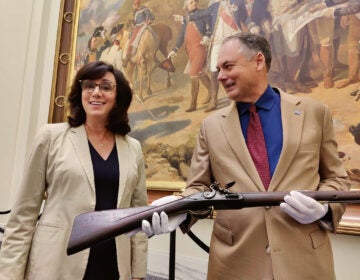Life of Wyeth reflected in “time capsule” that is Chadds Ford, PA
This weekend, visitors will gather at the Brandywine River Museum in Chadds Ford. The museum hosts a memorial tribute to iconic painter Andrew Wyeth. That Pennsylvania area served as the inspiration for his legendary landscapes. From WHYY’s Arts and Culture desk, Alex Schmidt reports on a place that’s both changed and stayed the same.
This weekend, visitors will gather at the Brandywine River Museum in Chadds Ford. The museum hosts a memorial tribute to iconic painter Andrew Wyeth. That Pennsylvania area served as the inspiration for his legendary landscapes. From WHYY’s Arts and Culture desk, Alex Schmidt reports on a place that’s both changed and stayed the same. [audio: arts20090130.mp3]
Transcript:
Driving into Chadds Ford from Philadelphia, the surroundings look a lot like any other American suburb, with car dealerships and telephone poles. But every year over 100,000 people turn off Route 1 to explore the Brandywine River Museum and the land around it. Jim Duff is director of the museum. He takes me for a drive around the area.
Duff: “We’re headed to the Kuerner Farm, one of the most important places in Andrew Wyeth’s life and career. He discovered the Kuerner Farm when he was a teenager, not far from his own home a mile walk, really. Of course Chadds Ford was then a very rural community.”
Away from the stoplights, remnants of that rural community survive. The Kuerner Farm is a short ride away from the museum. It’s on land officially protected by the Brandywine Conservancy, the parent foundation of the museum. The farm sits at the bottom of a small valley, like cherries in a bowl. We get out of the car near the barn, and look up toward the hill that Wyeth painted countless times. The color of the dried grass is the same dull brown as in his paintings. Flecks of snow sprinkle across the ground in front of us.
Duff: “We’re out here on a winter day, the kind of day Andrew Wyeth loved. He loved cold and he loved snow, and he loved this landscape when it was at its rawest.”
Wyeth was preoccupied with the sparseness of rural life and there was often an intensely personal, dark side to his paintings. Duff says Wyeth was obsessed with death after his father died.
Duff: “He always said the hill represented his father, the great shape of the hill, and when his father died he regretted that he had never painted him.”
Wyeth is criticized by his detractors for idealizing a romantic, rural version of America that is said to no longer exists. As we walk around the barn, we run right into an heir of those earlier times.
Duff: “Hi Karl – it’s Karl Kuerner the third.”
He’s the grandson of Karl Kuerner senior, the German immigrant who established this farm in the 1920s and was a favorite subject of Andrew Wyeth. He still works on the farm, with its few animals and hay in the loft. He opens the door of his gigantic red barn with his key and we walk inside. It’s pitch black inside.
Kuerner: “You may wanna hold my hand. Follow me to the left and see how big it really is. Just go right on in.”
It’s frigid upstairs and there are piles of hay twenty feet high to the ceiling. Light streams in through an opening at the very top. This isn’t a site that Andrew Wyeth painted, but he may have wanted to, had he lived longer.
Duff: “Our world is changed because we’ve lost a wonderful personality and a great artist, but it’s changed greatly because there won’t be any more new paintings. And we’d gotten used to that. And I thought maybe there wouldn’t be an end to it.”
The Brandywine Conservancy can ensure that the land Wyeth painted doesn’t change. And though Wyeth’s critics disparage his work for sentimentality and attachment to the past, right now, those things feel pretty good.
More information
Christina’s World, Wyeth’s most famous painting, will be at the Brandywine River Museum this weekend. The painting is on loan, from two days, from its permanent home at New York’s Museum of Modern Art.
WHYY is your source for fact-based, in-depth journalism and information. As a nonprofit organization, we rely on financial support from readers like you. Please give today.




